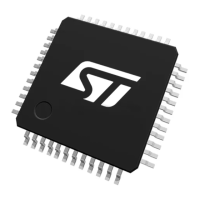Universal serial bus full-speed host/device interface (USB) RM0444
1298/1390 RM0444 Rev 5
Bit 11 SETUP: Setup transaction completed
– Device mode
This bit is read-only and it is set by the hardware when the last completed transaction is a
SETUP. This bit changes its value only for control endpoints. It must be examined, in the
case of a successful receive transaction (VTRX event), to determine the type of transaction
occurred. To protect the interrupt service routine from the changes in SETUP bits due to
next incoming tokens, this bit is kept frozen while VTRX bit is at 1; its state changes when
VTRX is at 0. This bit is read-only.
– Host mode
This bit is set by the software to send a SETUP transaction on a control endpoint. This bit
changes its value only for control endpoints. It is cleared by hardware when the SETUP
transaction is acknowledged and VTTX interrupt generated.
Bits 10:9 UTYPE[1:0]: USB type of transaction
These bits configure the behavior of this endpoint/channel as described in Table 225:
Endpoint/channel type encoding. Channel0/Endpoint0 must always be a control
endpoint/channel and each USB function must have at least one control endpoint/channel
which has address 0, but there may be other control channels/endpoints if required. Only
control channels/endpoints handle SETUP transactions, which are ignored by endpoints of
other kinds. SETUP transactions cannot be answered with NAK or STALL. If a control
endpoint/channel is defined as NAK, the USB peripheral does not answer, simulating a
receive error, in the receive direction when a SETUP transaction is received. If the control
endpoint/channel is defined as STALL in the receive direction, then the SETUP packet is
accepted anyway, transferring data and issuing the CTR interrupt. The reception of OUT
transactions is handled in the normal way, even if the endpoint/channel is a control one.
Bulk and interrupt endpoints have very similar behavior and they differ only in the special
feature available using the EPKIND configuration bit.
The usage of isochronous channels/endpoints is explained in Section 37.5.5: Isochronous
transfers in Device mode
Bit 8 EPKIND: endpoint/channel kind
The meaning of this bit depends on the endpoint/channel type configured by the UTYPE
bits. Table 226 summarizes the different meanings.
DBL_BUF: This bit is set by the software to enable the double-buffering feature for this bulk
endpoint. The usage of double-buffered bulk endpoints is explained in Section 37.5.3:
Double-buffered endpoints and usage in Device mode.
STATUS_OUT: This bit is set by the software to indicate that a
status out transaction is
expected: in this case all OUT transactions containing more than zero data bytes are
answered ‘STALL’ instead of ‘ACK’. This bit may be used to improve the robustness of the
application to protocol errors during control transfers and its usage is intended for control
endpoints only. When STATUS_OUT is reset, OUT transactions can have any number of
bytes, as required.
Bit 7 VTTX: Valid USB transaction transmitted
– Device mode
This bit is set by the hardware when an IN transaction is successfully completed on this
endpoint; the software can only clear this bit. If the CTRM bit in the USB_CNTR register is
set accordingly, a generic interrupt condition is generated together with the endpoint related
interrupt condition, which is always activated.
A transaction ended with a NAK or STALL handshake does not set this bit, since no data is
actually transferred, as in the case of protocol errors or data toggle mismatches.
This bit is read/write but only 0 can be written.
– Host mode
Same as VTRX behavior but for USB OUT and SETUP transactions.

